



This research categorizes and analyzes different online fashion store studies conducted over the past 10 years based on study type. The results are as follows. First, it was found that 116 studies out of 118 studies on online fashion stores conducted from 2000 to 2012 were based on PC web. Second, the studies on PC web-based fashion stores were reclassified into 9 different categories based on their topics: purchase behavior, word-of-mouth behavior, website, and product information presentation as well as products for sale, return behavior, customer service, system, present condition, marketing strategy, and promotions. However, mobile web-based studies were categorized into 2 categories of introduction of the fashion stores and purchase behavior. Third, we reclassified the studies chronologically to observe studies conducted at different times. In the early phase (in addition to studies on purchase behavior) studies on present condition, marketing strategy, and website constituted the majority of studies conducted because the field research was just starting to grow; however, studies conducted in the latter phase showed new patterns of study, such as word-of-mouth effect, and return behavior. Future studies conducted on competitive PC web-based fashion stores require a more specific classification of studies (according to their purpose) to develop an effective marketing strategy.
인터넷쇼핑몰로 대표되는 전자상거래는 PC와 인터넷의 보편화를 기반으로 접근성, 편리성 등 기존유통경로와는 차별화 된 특성을 통해 짧은 시간 안에 시장 내 주요 유통경로로 자리 잡았다. 인터넷망의 안정화와 더불어 다양한 결제시스템의 도입 등 기술적 향상이 동반된 가운데, 2010년 사이버 쇼핑을 통한 소매거래액은 총 25조 1550억 원으로 이는 전체 소매판매액의 9.1% 에 해당하는 수치이다. 이처럼 전체 소비시장에서 사이버시장의 영향력이 점차 커져가는 가운데, 특히 시장 안에서 두드러지는 상품군이 바로 의류 및 패션관련 상품이다. 2010년 사이버쇼핑을 통한 전체 거래액 중 가장 높은 비율을 차지하고 있는 의류 및 패션관련 상품은 거래액 규모만을 놓고 본다면 사이버 시장 내 가장 경쟁력있는 상품군으로 평가할 수 있을 것이다(Statistics Korea, 2010). 그러나 실제 사이버시장에 진입한 의류업체들의 생존율은 매우 낮은 것이 현실로, 인터넷이라는 경로의 특성상 유형의 점포를 필요로 하는 다른 유통경로에 비해 진입의 장벽이 낮고, 특히 의류의 경우 소자본으로 시작이 용이하다는 점과 신고만으로 시작할 수 있다는 사업전개의 간편함 때문에 타 업종보다 시장 내 유입속도가 빨라 경쟁 현상은 더욱 심화되고 있는 실정이다(“Clothing & Accessories”, 2007). 이렇듯 과열된 경쟁 속에서 생존을 위한 전략연구의 중요성이 더욱 높아진 가운데, 시장이 활성화되기 시작한 2000년대를 기점으로 의류학분야에서 역시 관련연구가 차지하는 비율이 증가하고 있다. 이에 본 연구는 사이버시장 내 의류쇼핑몰에 대한 연구가 꾸준히 진행되어온 가운데, 지난 10여 년간 진행된 관련연구의 경향을 분석함으로 향후 웹 기반의 의류쇼핑몰 연구가 나아갈 방향을 제시하고자한다. 더불어 양적팽창과 함께 갈수록 세분화되고 있는 의류쇼핑몰 시장의 효과적인 연구를 위하여 기존 웹 기반의 의류쇼핑몰 연구에 사용된 쇼핑몰유형을 분석하고자 한다.
신(新) 유통경로로 웹 기반의 쇼핑몰이 등장한 이후, 새롭게 형성된 인터넷 시장은 많은 연구자들에 의해 다양한 각도로 연구되어왔다. 의류학 분야 역시 쇼핑몰이 활성화되기 시작한 2000년대를 전후로 다양한 연구가 진행되어 왔으며, 이러한 연구는 지금까지도 꾸준히 이어지고 있다. 이에 본 연구에서는 웹 기반의 의류쇼핑몰 시장에 대한 선행연구 분석을 통해 지난 2000년부터 최근까지 진행된 10여 년 간의 관련 연구유형을 분류하고, 나아가 세분화되고 있는 의류쇼핑몰 시장의 효과적인 연구를 위하여 기존 웹 기반의 의류쇼핑몰 연구에 사용된 쇼핑몰유형을 분석하고자 한다.
본 연구의 연구내용은 다음과 같다.
첫째, 기존 웹 기반의 의류쇼핑몰 연구들을 연구주제에 따라 유형별로 분류한다.
둘째, 기존 웹 기반의 의류쇼핑몰 연구들을 웹 기반에 따라 유형별로 분류한다.
셋째, 연구주제에 따라 분류된 기존의 웹 기반의 의류쇼핑몰
[Table 1.] The type of previous online fashion store studies on PC web-based
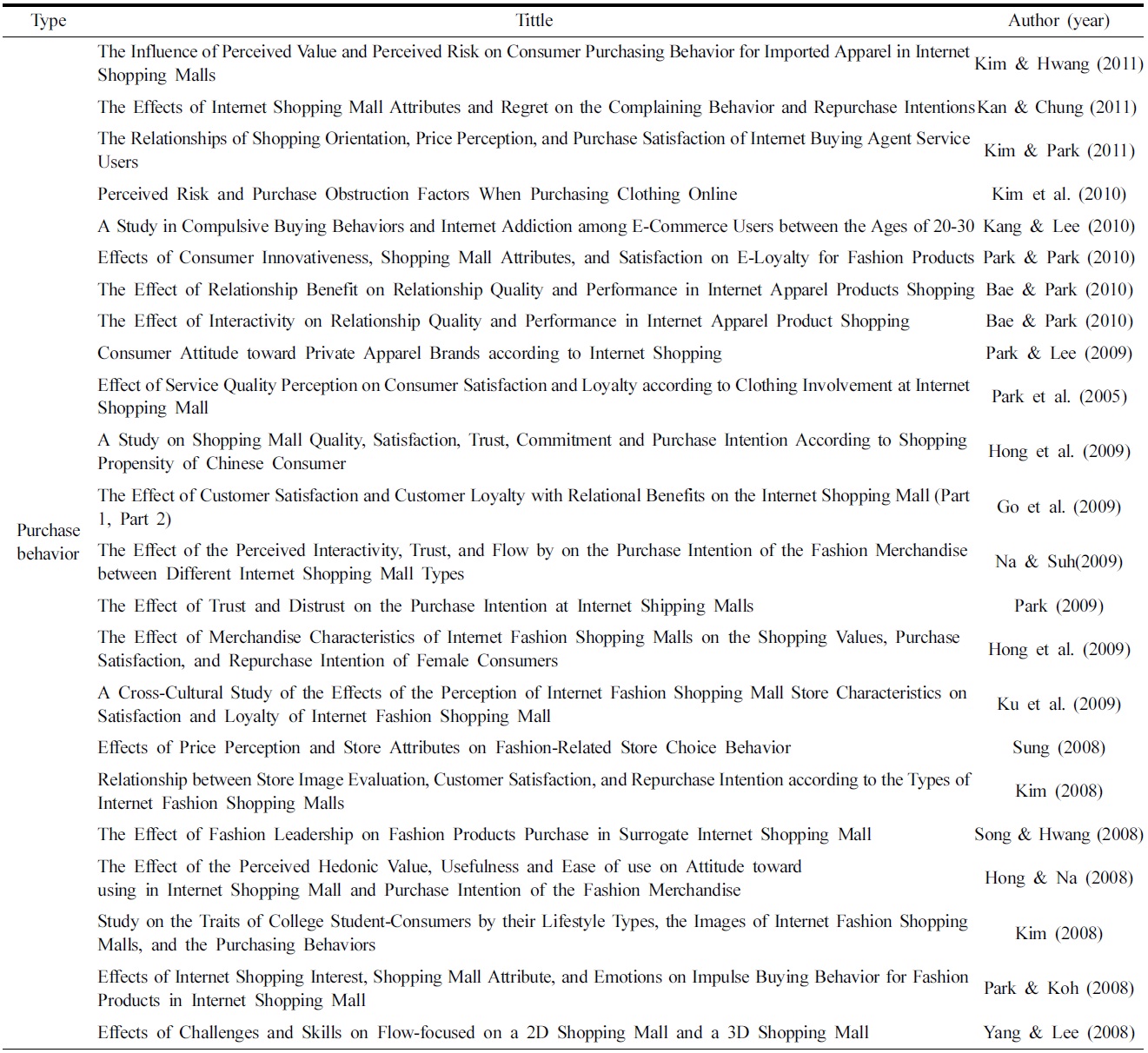
The type of previous online fashion store studies on PC web-based
연구들을 연대 별로 분류하여 시대별 연구경향을 분석한다.
넷째, 기존의 웹 기반의 의류쇼핑몰 연구에 사용된 쇼핑몰유형을 분석한다.
본 연구는 웹 기반의 의류쇼핑몰에 대한 선행연구를 분석하기 위한 것으로 국내 학술지를 분석하기위해 2011년 5월에 다음과 같은 기준에 따라 자료분석을 하였다.
첫째, 2000년도부터 2011년도 상반기까지 한국의류학회지 외 총 5개의 대표적인 의류관련 등재 학술지(복식, 복식문화학회지, 한국의류산업학회지, 대한가정학회지, 패션비즈니스)에 게재된 연구논문을 대상으로 하였다.
둘째, 연구대상 자료의 추출을 위해, 웹 기반의 의류쇼핑몰과
[Table 1-1.] The type of previous online fashion store studies on PC web-based (continued)
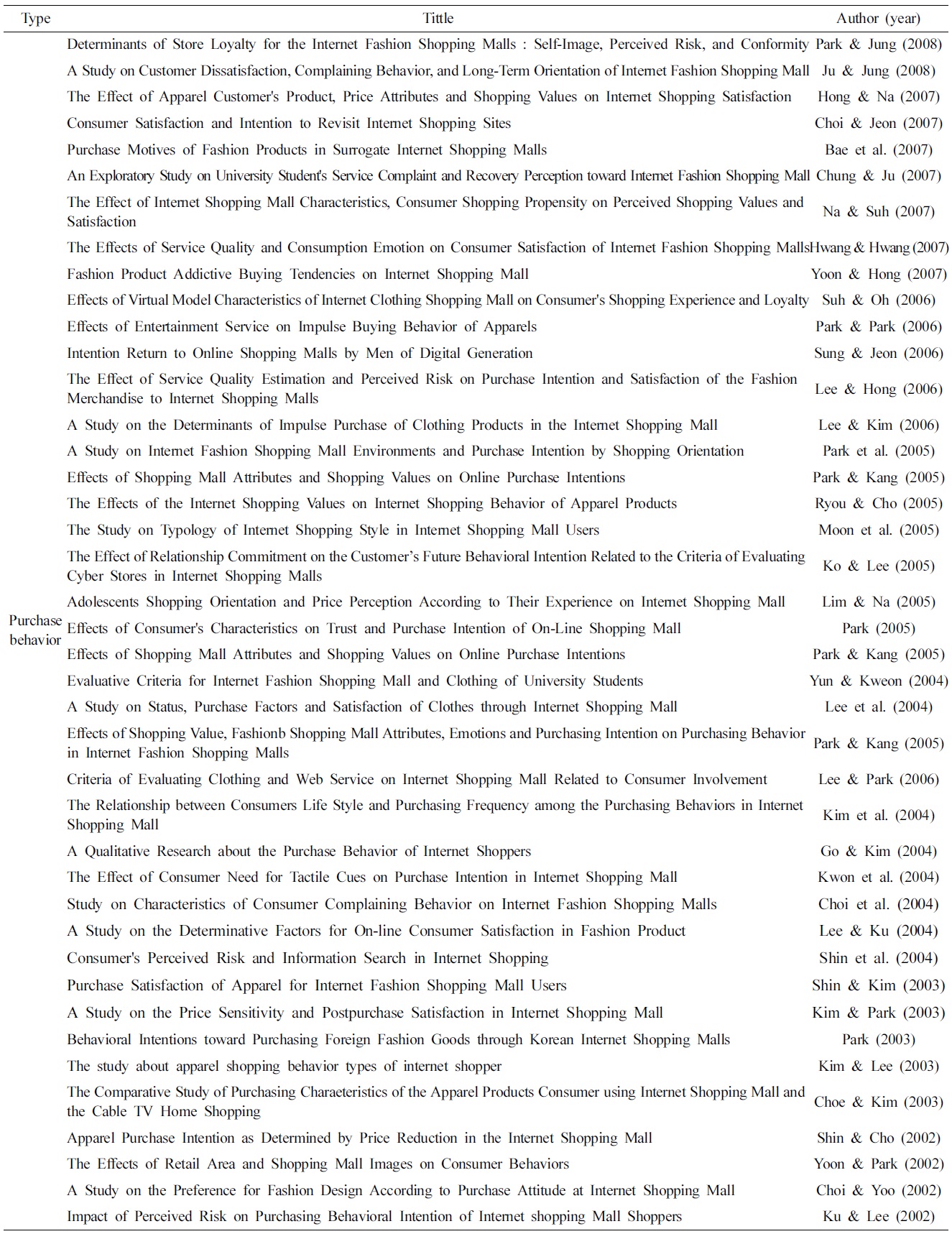
The type of previous online fashion store studies on PC web-based (continued)
[Table 1-2.] The type of previous online fashion store studies on PC web-based (continued)
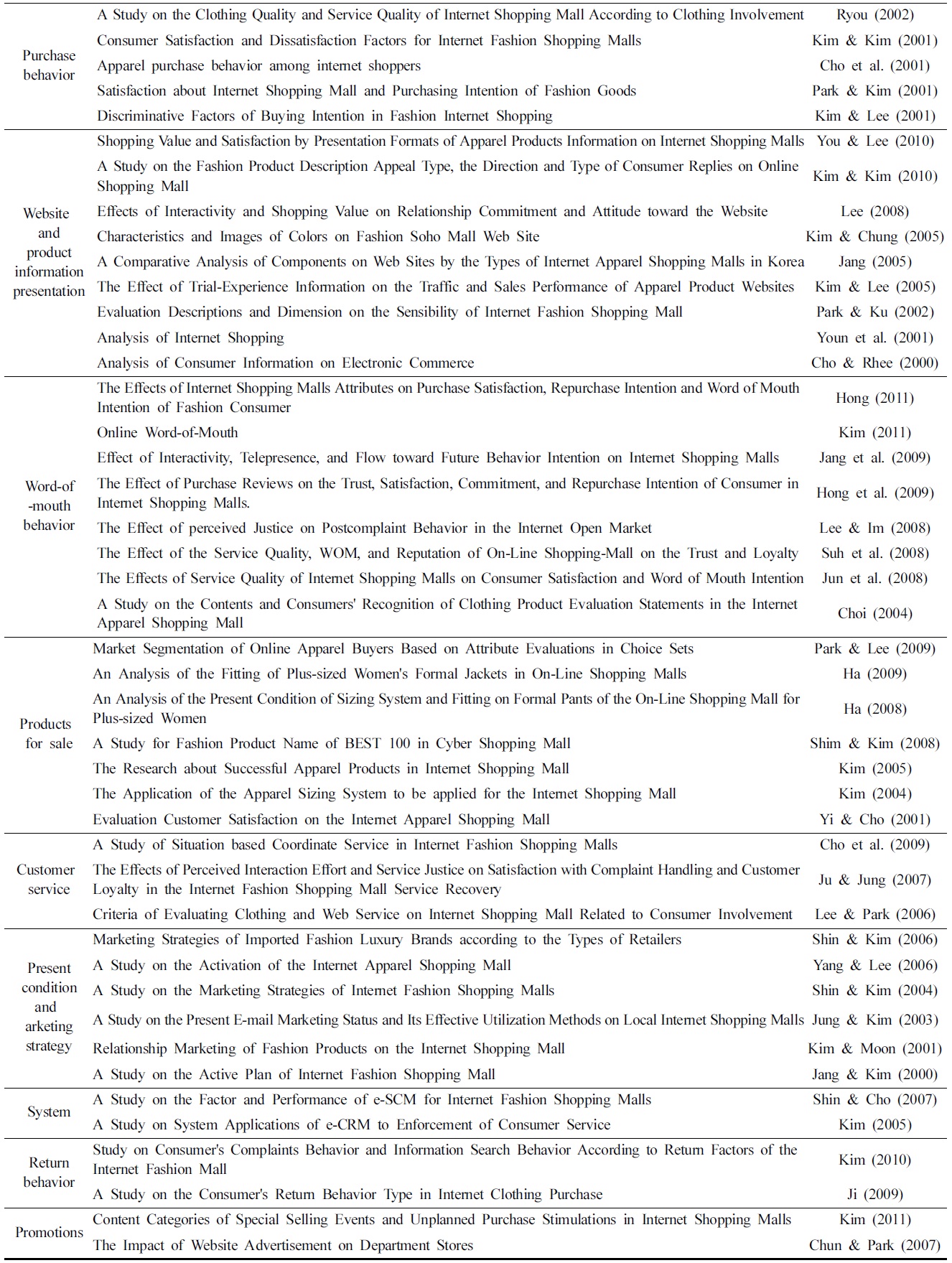
The type of previous online fashion store studies on PC web-based (continued)
관련된 것으로 ‘인터넷’, ‘인터넷 쇼핑몰’, ‘의류 쇼핑몰’, ‘전자상거래’, ‘사이버 쇼핑몰’, ‘모바일’, ‘모바일 쇼핑몰’, ‘모바일 쇼핑’, ‘어플리케이션’, ‘스마트폰’의 검색어로 KSIKISS(한국학술정보원), DBPIA(누리미디어), RISS(국내학술지논문) 등을 통해 검색하였으며, 이때 제목뿐만 아니라 키워드도 위의 조건에 해당되면 포함하였다.
단, 내용을 검색하여 내용이 일치하지 않는 자료는 제외하였으며, 그 결과 총 118편의 연구논문이 분석 자료로 사용되었다.
본 연구에서는 자료선정과 분석을 위해 교수 1인과 박사과정 1인의 연구자가 참여하여 심층적 토의와 의사교환을 통해 내용타당도를 검증하는 전문가 접근방법(Burns, 1996)을 사용하였다. 선정된 논문의 분석은 다음의 방법으로 이루어졌다
첫째, 선정된 논문의 연구유형 명칭은 주제와 내용에 따라 항목들을 대표할 수 있는 것으로 선정하였다. 이때, 유형분류에 있어 연구변인들이 중복되는 경우는 연구변인의 비중에 있어 본 연구에 더 적합하다고 판단되는 유형으로 분류하였다.
둘째, 기존연구의 유형 분류는 웹 기반, 연구주제, 연대를 기준으로 나누었으며, 더불어 기존연구에 사용된 쇼핑몰유형을 분석한 다음 그 결과를 표와 그래프 를 통해 제시하였다.
셋째, 본 연구에 사용된 분석방법은 전문가 접근방법 외에 기술통계 및 빈도분석등이 사용되었으며, 이에 따른 통계적 결과는 모두 표를 통해 제시하였다
3.1. 연구주제에 따른 웹 기반의 의류쇼핑몰 연구 유형
웹 기반의 의류쇼핑몰에 대한 기존연구의 흐름을 살펴보기 위하여 지난 10 여 년간 진행된 기존연구들을 주제에 따라 분류하였다. 그 결과, 지난 10년간 진행된 PC 웹 기반의 의류쇼핑몰 연구는 의류쇼핑몰의 구매행동 관련연구, 웹 사이트 및 상품정보 제시 관련연구, 판매상품 관련연구, 서비스 관련연구, 시스템 관련연구, 현황 및 마케팅전략 관련연구, 프로모션 관련연구의 7가지 유형으로 분류 할 수 있었다. 그러나 구매행동관련 연구의 경우, 그 주제의 범위가 너무 큰 관계로 구매행동관련연구 중, 구매 후 행동인 구전행동과 반품행동을 따로 분류하였다. 그 결과, 지난 10년간 진행된 PC 웹 기반의 의류쇼핑몰 연구는 주제에 따라 의류쇼핑몰의 구매행동 관련연구, 웹 사이트 및 상품정보 제시 관련연구, 판매상품 관련연구, 서비스 관련연구, 시스템 관련연구, 현황 및 마케팅전략 관련연구, 프로모션
[Table 2.] The type of previous online fashion store studies on mobile web-based

The type of previous online fashion store studies on mobile web-based
관련연구, 구전행동 관련연구, 반품행동 관련연구의 총 9가지 유형으로 분류할 수 있었다.
반면, 모바일 웹 기반의 의류쇼핑몰 연구의 경우, 주제에 따라 모바일 웹 기반의 의류쇼핑몰 도입에 관한 연구와 모바일의류 쇼핑몰 구매행동과 관련된 연구의 2가지 유형으로 나눠졌다(Table 1, Table 2).
다음은 연구주제에 따라 분류된 논문을 웹 기반의 종류에 따라 재분류하였다. 그 결과, 웹은 PC를 기반으로 하는 PC 웹과 스마트폰을 기반으로 하는 모바일 웹 중, PC 웹 기반의 의류 쇼핑몰에 대한 연구가 116편, 모바일 웹 기반의 의류쇼핑몰에 대한 연구가 2편인 것으로 나타나, 2000년대 이후부터 진행된 웹 기반의 의류쇼핑몰에 대한 대다수의 연구들이 PC 웹 기반을 중심으로 이뤄져 왔음을 알 수 있었다(Table 3).
반면, 모바일 웹 기반의 의류쇼핑몰 시장에 대한 선행연구의 경우, 아직까지 연구의 양이 미비한 것으로 나타났다. 모바일 웹 기반의 의류쇼핑몰에 대한 선행연구는 총 2편으로 신(新)유통경로로 등장한 모바일 웹 기반의 의류쇼핑몰 도입에 관한 연구와 모바일의류 쇼핑몰 구매행동과 관련된 연구로 나눠졌다(Table 2, Table 3). 모바일 시장이 최근에 활성화되기 시작한 시장이므로 아직까지 관련 연구의 양이나 분야가 미비한 것으로 나타났다. 따라서 향후 모바일 웹 기반의 의류쇼핑몰 시장에 대한 다양한 각도에서의 연구가 필요할 것으로 보인다. 또한 현재 운영되고 있는 대다수의 모바일 웹 기반의 의류쇼핑몰들이 PC 웹 기반의 의류쇼핑몰에서 확장되었다는 점에서 향후에는 모바일과 PC 웹 기반의 의류쇼핑몰에 대한 통합적인 연구 역시 필요할 것으로 생각된다.
3.3. 연대별 웹 기반의 의류쇼핑몰 선행연구현황 분석
웹 기반의 의류쇼핑몰 연구현황을 살펴보기 위해 연구주제에 따라 분류된 논문을 연대별로 재분류하였다. 4년을 주기로 각 연대를 초반기(2000년~2003년), 중반기(2004년~2007년), 후반기(2008년~2011년)로 분류하였으며, 분류된 각 연대별 연구 현황은 Table 4와 같다.
웹 기반의 의류쇼핑몰 연구의 흐름을 연대별로 살펴본 결과, 초반기는 일반적인 구매행동 관련연구와 더불어 현황 및 마케팅 전략분석과 사이트에 대한 연구가 이루어졌다. 이는 웹기반의 의류쇼핑몰이 시작단계였던 시기적 특성 때문에 아직까지 다양한 각도에서의 세분화된 연구가 진행되지 못해 나타난 결과로 추측된다. 그러나 중반기에 접어들며, 한정적이던 연구들은
[Table 3.] The categorization of previous online fashion store studies based on their topics
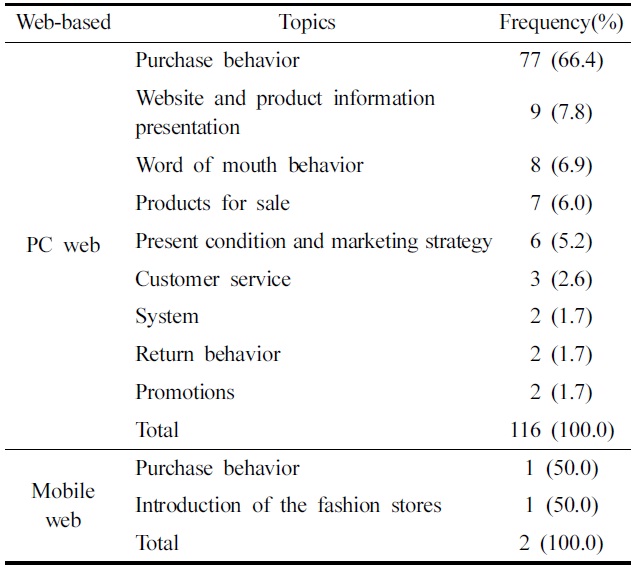
The categorization of previous online fashion store studies based on their topics
서비스 관련연구나 시스템 관련연구 등 조금 더 다양한 주제로 진행되었다. 또한 초반기부터 꾸준히 진행되어온 구매행동 관련연구에서도 구매중독 관련연구와 같이 좀 더 세분화된 연구가 이루어지며, 초반기와 비교했을 때 전반적으로 다양한 주제가 다루어지고 있음을 알 수 있다. 후반기 역시 중반기와 마찬가지로 다양한 주제의 연구가 이루어졌다. 그 중에서도 특히 구전효과나 반품행동과 같이 구매 이후에 나타나는 행동들에 대한 연구가 두드러지고 있는데, 이는 시장형성이후, 시간경과와 더불어 판매 후 소비자 관리가 중요해짐에 따라 이루어진 결과로 보여진다. 시간이 지남에 따라 구매 후 행동인 반품행동이나 구전행동과 관련된 연구는 더욱 활성화 될 것으로 예측되는 가운데, 최근 스마트폰시장의 성장과 더불어 SNS의 영향력이 주목받고 있는 시점에서 이와 관련된 온라인 구전효과에 대한 연구가 필요할 것으로 생각된다.
한편, 연대에 따라 나눠진 연구들을 주제에 따라 분석해보면,
[Table 4.] The analysis of previous online fashion store studies on PC web-based chronologically
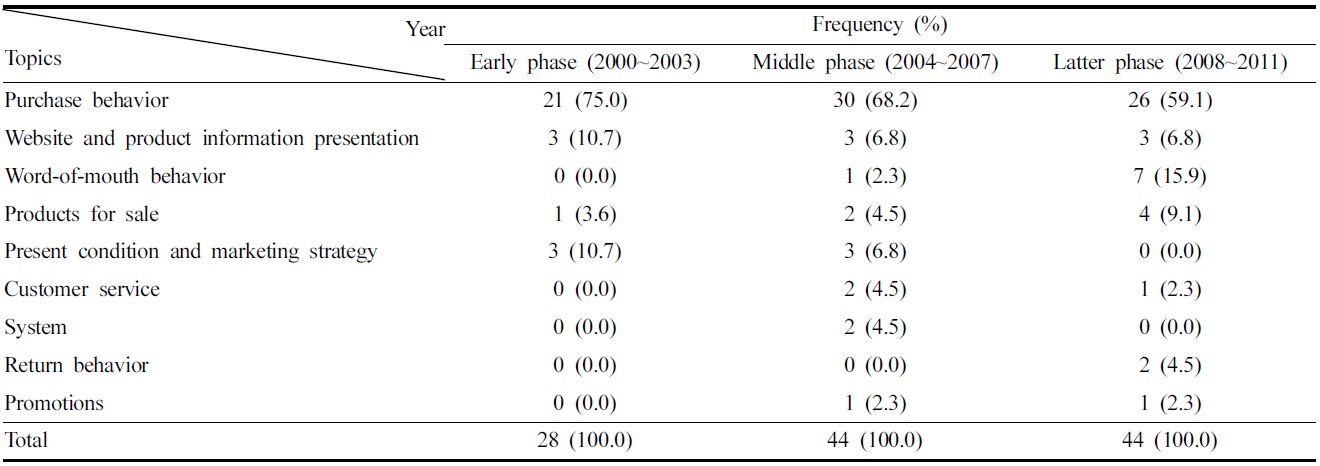
The analysis of previous online fashion store studies on PC web-based chronologically
구매행동 관련연구와 웹 사이트 및 상품정보 제시 관련연구의 경우, 2000년 이후부터 현재까지 꾸준히 이뤄지고 있는 것을 알 수 있다. 특히 구매행동의 경우, 소비자의 성향이 갈수록 빠르게 변화하고 있어 앞으로도 지속적인 연구가 이뤄져야 할 것이다. 반면, 현황 및 마케팅전략 관련연구의 경우 초, 중반기까지 계속되던 연구가 후반기에 들어서며 거의 전무한 것으로 나타났다. 시장 내 진입의 용이함으로 갈수록 심화된 경쟁상황에서 시장에 대한 전반적인 분석과 성공한 쇼핑몰들에 대한 마케팅 전략 연구는 반드시 필요하다. 특히 새로운 파생경로로 모바일시장이 부각되는 시점에서 두 경로간의 상생전략 및 새로운 시장으로 인해 확대된 시장전반에 대한 연구가 이뤄져야 할 것이다.
반면, 모바일 웹 기반의 의류쇼핑몰 시장 연구의 경우, 모바일 시장이 최근에 활성화되기 시작한 시장이므로 아직까지 관련 연구의 양이나 분야가 미비한 것으로 나타났다. 분석에 사용된 2개의 논문 모두 2000년대 후반에 진행된 것으로 일반적인 구매행동과 모바일 웹 기반의 의류쇼핑몰 도입에 관한 연구에 국한된 것을 볼 수 있다. 최근 스마트폰의 활성화와 더불어 이와 관련된 연구가 활발히 이루어지고 있는 만큼 이후 모바일 웹 기반의 의류쇼핑몰 시장에 대한 다양한 시각에서의 연구가 필요할 것으로 보인다.
의류쇼핑몰 시장의 성장과 더불어 등장한 다양한 형태의 쇼핑몰들은 지난 10여 년간 웹 기반의 의류쇼핑몰 연구에 중요한 변수로 사용되어왔다. 통계청의 분류법에 따르면 쇼핑몰의 유형은 크게 취급상품의 범위를 기준으로 하는 것과 쇼핑몰 운영 형태를 기준으로 하는 두 가지 방법을 통해 나눌 수 있다. 취급상품의 범위에 따른 분류의 경우, 각종 상품군으로 이뤄진 종합몰(G마켓, 11번가 등)과 하나 혹은 주된 특정 카테고리 상품군으로 이뤄진 전문몰(패션플러스, 스타일난다 등)의 두 가지 형태로 분류하는 반면, 운영형태에 따른 분류에서는 오직 사이버상의 매장으로만 이뤄진 on-line몰과 사이버상의 매장과 오프라인 매장 모두를 갖고 있는 on/off-line 병행몰로 분류하고 있다.
의류쇼핑몰 유형을 중요한 변수로 사용 선행연구를 살펴보면, Hong(2011)의 연구는 인터넷 쇼핑몰유형을 전문형, 종합형, 오픈마켓으로 나눠 각 유형에 따라 패션소비자가 지각하는 인터넷 쇼핑몰 속성의 차이를 밝혔다. 그 결과, 전문형 쇼핑몰 이용자의 경우 종합형 쇼핑몰이나 오픈마켓 이용자보다 사이트 구성이나 패션상품 속성을 더 높게 인식하는 반면, 판촉서비스는 더 낮게 인식하는 것으로 나타났다.
Park and Lee(2009)의 연구는 인터넷 쇼핑몰유형을 전문몰과 종합몰로 나누고, 유형에 따라 소비자의 자체 의류 상표에 대한 태도의 차이를 밝혔다. 그 결과, 전문몰의 경우, 주관적 규범이 전문몰 자체 의류상표에 대한 쾌락적 태도, 효용적 태도를 형성하는데 영향을 미치며, 특히 쾌락적 태도를 형성하는데 더 영향력이 큰 것으로 나타났다. 종합몰의 경우, 주관적 규범은 자체의류상표에 대한 쾌락적 태도, 효용적 태도에 영향을 줄뿐만 아니라, 구매의도 및 구전의도에도 영향을 주는 것으로 나타났다. 특히 주관적 규범은 전문몰보다 종합몰의 다차원적 태도에 미치는 영향에 있어 그 유의수준이 더 높게 나타나 활용가치가 더 높다고 해석하고 있다.
Na and Suh(2009)의 연구는 인터넷 쇼핑몰유형을 전문몰과 종합몰로 나누고, 유형에 따른 지각된 상호작용, 신뢰, Flow가 패션상품 구매의도에 미치는 영향을 밝혔다. 그 결과, 종합몰과 전문몰 모두 지각된 신뢰, 유용성, Flow, 이용태도의 모든 요인들이 패션상품 구매의도에 영향을 미치는 것으로 나타났다. 영향정도에 대해서는 종합몰과 전문몰 모두 인터넷 패션 쇼핑몰에 대한 쇼핑몰 태도, 지각된 신뢰의 순으로 영향을 미쳤으며, 그 다음 종합몰의 경우, Flow 보다는 유용성이, 전문몰의 경우, 유용성보다는 Flow가 더 구매의도에 영향을 미치는 것으로 나타나 쇼핑몰유형에 따라 어느 정도 차이가 있음이 밝혀졌다.
Kim(2008)의 연구는 인터넷 쇼핑몰유형을 전문몰과 종합몰로 나누고, 유형에 따른 점포이미지가 고객만족에 영향을 미치는데 있어 차이점이 있는지를 밝혔다. 그 결과, 종합몰의 경우, 제품 및 정보서비스, 구매 후 고객서비스, 분위기, 편리성, 신뢰성 등 5가지 점포이미지 차원 모두 영향을 미치는 것으로 나타났다. 특히, 고객만족에 가장 큰 영향을 미치는 요인은 편리성이며, 그 다음 구매 후 고객서비스, 제품 및 정보서비스, 신뢰성의 순으로 영향을 미치는 것으로 나타났다. 반면, 전문몰의 경우, 제품 및 정보서비스와 편리성이 만족도에 영향을 미치지 않는 것으로 나타나 편리성이 가장 큰 영향요인으로 나타난 종합몰과
[Table 5.] The type of online fashion store used for previous studies

The type of online fashion store used for previous studies
비교했을 때, 고객만족에 영향을 미치는 점포이미지가 유형에 따라 차이가 있음이 밝혀졌다.
Choi and Jeon(2007)의 연구는 인터넷 쇼핑몰유형을 전문몰과 종합몰로 나누고, 패션제품을 판매하는 인터넷 전문몰과 종합몰에 대한 소비자 만족도와 재방문의도에 영향을 미치는 요인을 밝혔다. 그 결과, 인구통계학적 특성들은 종합몰과 전문몰의 만족도나 재방문 의도에 전혀 영향을 미치지 않았으며, 서비스 요인 중 정보서비스 역시 어느 몰에서도 만족도에 유의한 영향을 주지 않았다. 반면, 사이트 구성이나 구매편의 및 혜택, 구매 후 서비스 요인들은 모두 만족도와 재방문의도에 영향을 주는 것으로 나타났으며, 특히, 전문몰에 비해 규모가 큰 종합몰에 대해 소비자의 서비스 요구수준이 높은 것으로 나타났다.
Park et al.(2002)의 연구는 인터넷 쇼핑몰유형을 Mall of Malls 쇼핑몰, 전문점형 쇼핑몰, 백화점형 쇼핑몰로 나누고, 쇼핑몰 유형에 따른 소비자 특성과 의복구매성향의 요인별 항목을 분석하였다. 먼저 쇼핑몰 유형에 따른 소비자특성을 살펴본 결과, Mall of Malls 쇼핑몰은 20대의 미혼여성들이, 백화점형 쇼핑몰은 30대의 미혼여성들이, 전문점형 쇼핑몰은 20대와 30대의 기혼여성들의 사용률이 높게 나타났다. 다음으로 쇼핑몰 유형에 따른 의복구매성향의 요인별 항목분석을 실시한 결과, 상품인식 요인 중 상품구색항목, 고객서비스 요인 중 신뢰성항목, 쇼핑경험요인 중 시·공간의 편리성 및 구매강요나 과잉서비스에 대한 보호항목, 경제적 위험지각 요인 중 잘못된 구매로 인한 수선이나 추가비용에 대한 위험항목이 의복구매성향 요인 내 유의성 있는 중요 변인으로 나타났다. 특히 상품구색과 상품정보의 신뢰성항목의 경우, 전문형 쇼핑몰이 다른 쇼핑몰에 비해 높게 나타났으며, 시·공간의 편리성의 경우 전문형 쇼핑몰과 더불어 Mall of Malls 쇼핑몰에서, 구매강요나 과잉 서비스에 대한 보호항목의 경우, 백화점형 쇼핑몰에서 높게 나타나 인지되는 변인의 중요성이 유형에 따라 차이가 있음이 나타났다.
이상, 선행연구에서 사용된 쇼핑몰 유형의 분류방법을 살펴 본 결과, 대다수의 연구들이 통계청의 분류법에 따라 의류쇼핑몰의 유형을 전문몰과 종합몰로 나누어 비교한 것을 알 수 있다(Table 5). 그러나 통계청의 분류법은 분류기준은 명확했으나 분류된 유형이 포괄할 수 있는 범위가 너무 넓어 의류쇼핑몰 유형 변수로는 조금 더 세분화된 분류가 필요 할 것으로 보인다. 반면, 세분화된 분류를 적용한 Park et al.(2002)의 연구에서는 세분화가 한쪽으로만 치우친 경향이 있어 균형 잡힌 유형 분류가 필요 할 것으로 보인다. 또한 업종에 따라 유형이 조금씩 달라짐을 고려해 볼 때, 각각의 업종을 고려한 차별화된 분류법이 필요할 것이다.
본 연구의 목적은 지난 10여 년간 진행된 웹 기반의 의류쇼핑몰 연구를 유형에 따라 분류, 분석하여 향후 웹 기반의 의류쇼핑몰 연구가 나아갈 방향을 제시하는 것으로 그 결과는 다음과 같다.
첫째, 지난 2000년부터 최근까지, 지난 10여 년 간 발표된 웹 기반의 의류쇼핑몰에 대한 연구 118편을 분석한 결과, 연구 중 무려 116편이 PC 웹 기반의 의류쇼핑몰에 대한 연구로 지금까지 관련연구는 대부분 PC 웹 기반의 의류쇼핑몰 연구를 중심으로 이뤄져온 것을 알 수 있었다.
둘째, 기반에 따라 나눠진 유형을 다시 연구주제별로 분류한 결과, PC 웹 기반의 의류쇼핑몰 연구는 의류쇼핑몰의 구매행동 관련연구, 구전행동 관련연구, 웹 사이트 및 상품정보 제시 관련연구, 판매상품 관련연구, 반품행동 관련연구, 서비스 관련 연구, 시스템 관련연구, 현황 및 마케팅전략 관련연구, 프로모션 관련연구의 9가지 유형으로 분류할 수 있었다. 반면, 모바일 웹 기반의 의류쇼핑몰 연구는 의류쇼핑몰 도입에 관한 연구와 구매행동에 관한 연구의 2가지 유형으로, 연구의 양과 질적인 부분 모두에 있어 아직 미비한 것으로 나타났다.
셋째, 지난 10여 년간 진행된 연구의 연대별 흐름을 살펴보기 위하여, 연구주제에 따라 분류된 논문을 연대별로 재분류하 였다. 각 연대를 4년을 주기로 초반기(2000년~2003년), 중반기(2004년~2007년), 후반기(2008년~2011년)로 나눠살펴본 결과, 초반기는 일반적인 구매행동 관련연구와 더불어 현황 및 마케팅 전략분석과 사이트에 대한 연구가 이루어졌다. 그러다 중반기에 접어들며 기존의 연구유형 외에도 서비스나 시스템 관련 연구, 프로모션 관련연구 등 초반기에 비해 좀 더 다양한 각도에서의 연구가 진행되었다. 연구의 양적인 부분 역시 초반기 28편이던 것이 중반기에는 44편으로 증가하였다. 반면, 후반기에 접어들어서는 초·중반기에는 거의 볼 수 없었던 구전효과나 반품행동과 같이 구매 이후에 나타나는 행동들에 대한 연구가 두드러졌다. 이는 시장경쟁이 본격화된 이후, 판매 후 소비자 관리의 중요성이 중요한 마케팅적 요소로 인식되었기 때문이라고 해석된다. 한편, 연대에 따라 나눠진 연구들을 주제에 따라 살펴본 결과, 구매행동 관련연구와 웹 사이트 및 상품정보 제시 관련연구의 경우 현재까지 꾸준히 이뤄지고 있는 반면, 현황 및 마케팅전략 관련연구의 경우 초, 중반기까지 계속되던 연구가 후반기에 들어서며 거의 전무한 것으로 나타났다.
넷째, 갈수록 세분화되고 있는 의류쇼핑몰 시장에 대한 효과적인 연구를 위해 선행연구에 사용된 의류쇼핑몰 유형과 각 유형별 연구내용을 살펴보았다. 그 결과, 대다수의 연구들이 의류 쇼핑몰의 유형을 통계청의 분류법에 따라 전문몰과 종합몰로 나누어 비교한 것을 확인했다. 선행연구들에 나타난 두 유형의 차이점을 살펴보면, 소비자들은 종합몰보다 전문몰의 사이트 구성이나 패션상품 속성을 더 높게 인식하는 반면, 판촉서비스를 낮게 인식하는 것으로 나타났다. 반면 종합몰의 경우, 고객만족에 가장 큰 영향을 미치는 요인이 점포이미지 차원 중 편리성인데 반해 전문몰의 경우, 편리성이 만족도에 영향을 미치지 않는 것으로 나타났으며, 또한 전문몰에 비해 규모가 큰 종합몰에 대해 소비자의 서비스 요구수준이 높은 것으로 나타나 쇼핑몰의 유형별 차이를 보이고 있었다. 이처럼 지금까지 선행연구에 제시된 쇼핑몰 유형을 살펴본 결과, 통계청의 분류법은 분류된 유형이 포괄할 수 있는 범위가 너무 넓어 조금 더 세분화된 분류가 필요 할 것으로 보이는 반면, 나머지 세분화된 분류를 적용한 다른 유형분류에서는 세분화가 한쪽으로만 치우친 경향이 나타났다.
이상, 지난 10여 년간 관련연구를 분석한 결과, 향후 관련연구가 나아가야할 방향은 다음과 같다.
첫째, 지난 10여 년간 대부분의 연구가 PC 웹 기반의 의류쇼핑몰 연구인 점을 감안, 최근 스마트폰수요의 폭발적 증가와 관련해 모바일 웹 기반의 의류쇼핑몰 시장이 갖게 될 시장성이 매우 긍정적으로 평가되는 바, 향후 모바일 웹 기반의 의류쇼핑몰 연구 역시 더욱 활성화 되어야 할 것이다. 또한 모바일 웹 기반의 의류쇼핑몰이 PC 웹 기반의 의류쇼핑몰에서 파생된 점을 감안하여 두 경로의 관련성 연구 역시 이뤄져야 할 것이다.
둘째, 시장경쟁이 본격화된 이후, 판매 후 소비자 관리의 중요성이 중요한 마케팅적 요소로 인식되며, 최근 구전효과나 반품 행동과 같이 구매 후 행동에 대한 연구가 두드러지는 가운데, 특히 최근 스마트폰시장의 폭발적 성장과 더불어 SNS의 영향력이 주목받고 있는 시점에서 이와 관련된 온라인 구전과 관련된 다양한 연구가 필요할 것으로 생각된다.
셋째, 시장진입의 용이함으로 갈수록 심화되고 있는 웹 기반의 의류쇼핑몰 시장상황을 고려했을 때, 시장에 대한 전반적인 분석과 성공한 쇼핑몰들에 대한 마케팅 전략 연구는 반드시 필요하며, 특히 새로운 파생경로로 모바일시장이 부각되는 시점에서 두 경로간의 상생전략 및 새로운 시장으로 인해 확대된 시장전반에 대한 연구가 이뤄져야 할 것이다.
이 외에도 갈수록 세분화되고 있는 의류쇼핑몰 시장의 효과적인 연구를 위하여, 지금까지 선행연구에 사용된 쇼핑몰 유형 분류가 모호한 기준, 상품특성 미반영, 포괄범위의 애매함 등 여러 문제점을 가지는 만큼, 상품특성을 고려한 명확한 분류기준의 세분화된 유형분류법 연구를 통해 새로운 쇼핑몰 유형분류가 제시되어야 할 것이다.
본 연구는 2000년대 이후 발표된 웹 기반의 의류쇼핑몰 연구를 분석한 것으로, 활성화된 PC 웹 기반의 의류쇼핑몰 연구와 함께, 최근 새롭게 형성된 모바일 웹 기반의 의류쇼핑몰 연구를 병행하였다. 앞으로의 후속연구에서는 경쟁구도가 과열된 PC 웹 기반의 의류쇼핑몰의 경우, 좀 더 효과적인 마케팅전략 수립을 위해 연구방향에 따라 세분화된 유형별 연구가 이루어져야 할 것이다. 반면, 모바일 웹의 의류쇼핑몰에 대한 연구는 연구 대상이 대부분 모바일 웹 기반의 의류 쇼핑몰 사용 경험이 전혀 없는 경우가 많아, 실제 경험이 있는 연구대상을 통한 실증적인 연구가 반드시 이뤄져야 할 것이다. 또한 모바일 웹기반의 의류쇼핑몰이 PC 웹 기반의 의류쇼핑몰에서 파생된 점을 감안해, 향후 시장 활성화 여부에 따라 두 유형간의 상관관계 연구역시 이뤄져야 할 것이며, 더불어 빠르게 급변하는 인터넷시장 변화에 대한 분석 연구 역시 꾸준히 축적되어 나가야 할 것이다.






